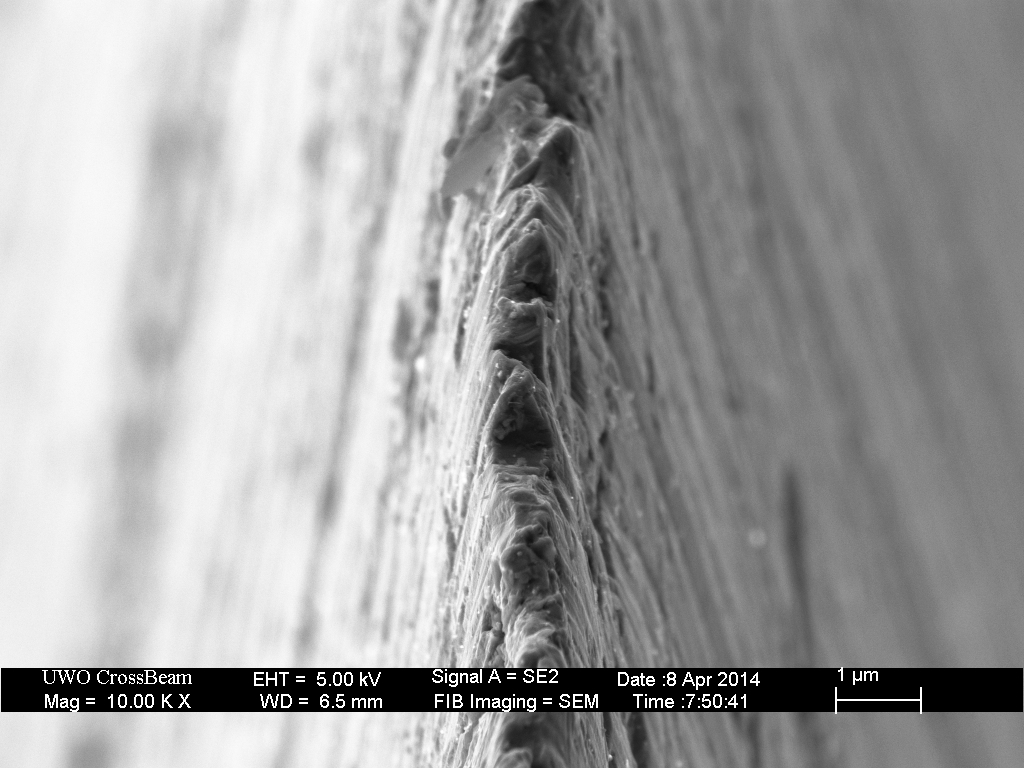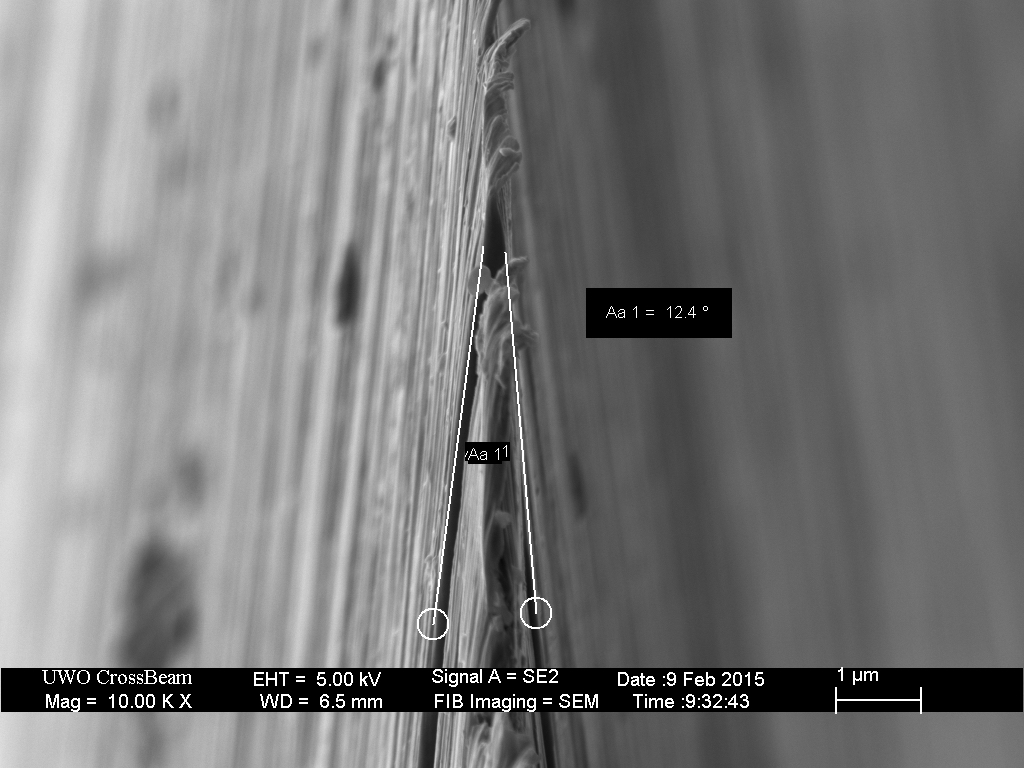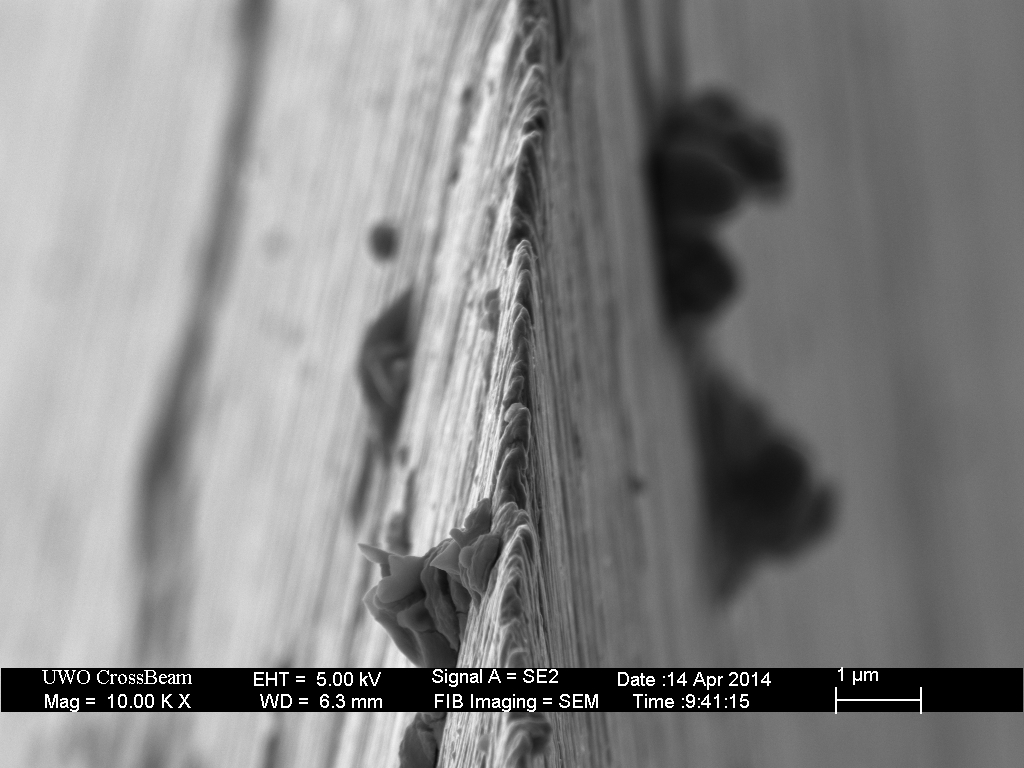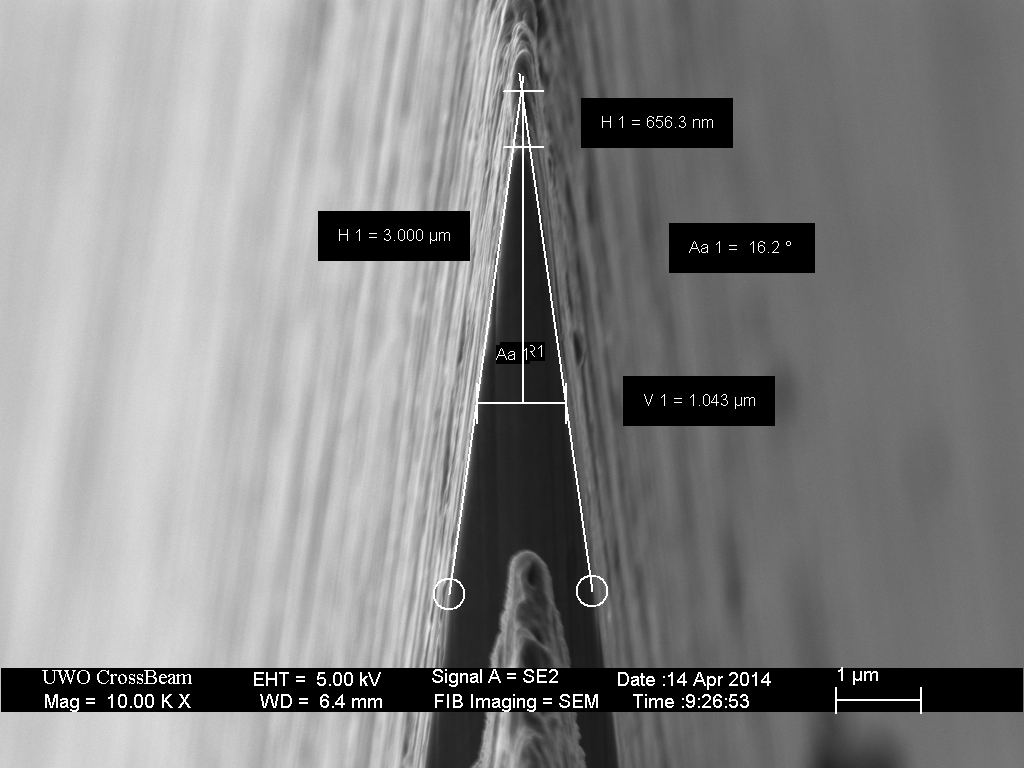The primary goal of stropping is to reduce the edge width by increasing the bevel angle near the apex (micro-convexity). Abrasive particles (paste, spray, etc) are applied to the strop to increase the rate of abrasion. The edge geometry that is achieved will depend on the type and size of abrasive, the strop material and the pressure and number of stropping laps applied. Although simple in principle, consistent results can be difficult to achieve due to the number of variables and their effects.
Abrasive stropping differs from conventional edge-leading honing in two ways; the trailing edge direction and the compressible nature of the substrate. Sharpening on a hard hone or stone in the edge-trailing direction provides the simplest case of pasted stropping; where compressibility does not play a role. As a starting point, I will discuss a comparison of edge-leading and edge-trailing honing.
When honing a blade in the edge-leading direction, steel is removed in two ways; abrasion of the bevel surface and the ‘breaking’ or ‘micro-chipping’ away of the apex. This micro-chipping process prevents the formation of a burr, but also limits the level of keenness that is achieved. In the edge-trailing stroke, the occurrence of micro-chipping is reduced to the point where a burr or foil will almost inevitably be formed. Two examples are shown below; honing on the Chosera 1k and on the Shapton Glass 16k. In both cases, the blade was honed normally with edge-leading strokes and then given 20 pairs of edge-trailing strokes approximately 10cm long.
Chosera 1k
Comparing edge-on view images, at the same magnification, shows the dramatic difference between edge leading and edge-trailing strokes.


The cross-section images confirm the formation of a foil edge in the edge-trailing case.


Shapton 16k



A comparison of the cross-sections confirms the formation of a burr in the edge-trailing strokes on the Shapton 16k also.



In summary, edge-trailing strokes can produce a keener edge than edge-leading; however, they generally result in the formation of an undesirable burr or foil.
In part 2 of The Pasted Strop the effect of a compressible substrate will be discussed.

44 responses to “The Pasted Strop – part 1”
Very interesting. I love these posts. Am I correct in that the second Shapton 16k image should read “edge trailing” and not “edge leading”?
LikeLike
Yes, thank-you, I have corrected that.
LikeLike
Great review, I’ll like to read the 2nd part.
LikeLike
Great post! I am amazed how much difference results from a simple change in honing direction. I wonder what happens when you hone in a back and forth motion (ie. alternating trailing and leading strokes).
Also, what about honing side-to-side?
LikeLike
The back and forth motion (half-strokes) will lead to a burr, just as with any honing that does not alternate sides. This is not necessarily a negative, depending on what you are trying to achieve. Other than during the final stages of honing, this is a very efficient way to remove metal.
As to strokes parallel to the edge, I have not looked at this, but I would expect the same result as edge-trailing.
LikeLiked by 1 person
It would be very interesting to look at the effects of strokes parallel to the edge, as this is the effect of many of the simpler sharpening gadgets sold for sharpening kitchen or utility knives. From my own experience experimenting with these types of gadgets, sharpening parallel to the edge produces a less effective cutting edge than either edge leading or edge trailing strokes. I have never had a microscope powerful enough to be able to prove it, but I imagine that strokes parallel to the edge end up tearing and rounding the edge instead of creating a keen apex with the micro-serrations that are so effective in cutting through the fibres of meat and vegetables.
If ever you have the time to extend the edge-leading / -trailing experiment to include parallel strokes, I would love to see the results.
LikeLiked by 1 person
How much of a factor is the type of steel? Do you think using a couple of edge trailing strokes after the final polishing strokes on the finishing stone would create a sturdy Mimi bevel?
LikeLike
There will be a number of factors, including the type of steel that will influence the result. The examples shown here should not be generalized, but rather serve as a starting point for further experimentation.
In the example I have shown, there is an increase in keenness with each edge-trailing stroke which, after 20 laps, leads to the production of a foil edge. At some point the apex was very keen, but a foil had not yet initiated. So yes, a few edge trailing strokes would be an effective finishing technique in this case.
LikeLiked by 1 person
Todd, I may have missed it, but could you specify approximately how much force was used and if you alternated sides on each pass or did multiple passes per side? thanks!
LikeLike
Josh,
These strokes were honed alternating sides. As a rule, I am using a force-equivalent on the order of 100 grams. Pressure is more relevant here, and that will decrease with increasing width of the bevel – this razor has a 0.3mm wide bevel.
LikeLike
1st, thank you for your work. I keep coming back and thinking about what I see and your conclusions. Do you think micro chipping size is a function of grit size at the hone, speed of collision with the grit particle and the layout of interstitial impurities in the lattice of the razor steel? If mostly from grit size, maybe the bigger chips are when the grit stays with hone and the smaller when the grit fractures or comes loose.
Or, if the effect is mostly from the razor, random lattice imperfections would dominate the chip geometry.
Ive seen both positions reported on the razor forums; some state a certain hone is bad to microchip, others state a certain steel. Of course the chips they reporting are much bigger optically observable.
LikeLike
In the (edge-leading) example shown here, the edge is abraded as micro-chips as we hone “through” the plane of the apex. It appears that for the coarser stone, the resulting edge is thicker and less linear implying the micro-chips become smaller with increasing grit. This is why the edge is observed to become keener as we progress through the hones.
The grain structure does not seem to play a determining role in these carbon steel razors; the edge geometry can be finer than the grain size. You can see the grain structure in this image
Certainly we should expect chipping would occur at weak points.
The micro-chipping referred to above is not visible with magnification below 500x. I have a suspicion that the effect described as micro-chipping in the context of the effect described as “over-honing” is related to the formation of a foil-edge burr. A foil edge will appear to be “micro-chipped” at modest magnification. It is known that burr formation depends on the properties of the steel.
LikeLike
The bur that is created from honing with back and forth motions/circles up to 5000k,
will it be removed by continued honing with only edge leading strokes with 5000k and 8000/10000 grit?
Thanks for all good posts!
LikeLike
Generally, a few edge-leading strokes alternating sides seems to remove any burr created by back and forth or edge trailing strokes. This does require contact of the apex to the stone, so this is not necessarily true for freehand honing or convex bevels.
LikeLike
The 50,000x magnification after Shapton 16k: should it be edge trailing strokes?
LikeLike
Yes, thank-you for pointing that out. The “20back” in the filename refers to 20 edge-trailing strokes.
LikeLike
Todd,
Incredible data. Myth busting at the highest level. I am still confused by the issue of deeper scratches by finer grit stones. I think I understand the force per size concept. As an alternative to the wood sanding analogy, would sword polishing progressions with Jnats add to the discussion. The finer and finer stone produce an increasingly mirrored finish which I assume is the result of diminished scratch depth. Is it possible that with increased honing at finer and finer grit that the depth of scratches diminishes on the bevel. It seems you did only a few laps on each grit which resulted in deeper scratches as you progressed. In other words would 100 laps on 600 grit following 325 yield a different result.
LikeLike
This effect is peculiar to diamond plates, in my experience. I believe that a small number of over-sized diamonds on the plates are responsible. There is an explanation in the “Diamond Plate Break-in part 2.”
The format of my blog articles may give the impression that these are one-time experiments or progressions. In fact, I have produced and examined edges honed on each of these plates numerous times under a number of conditions – varying the starting point (16k, 1k, etc), the pressure, number of strokes, until I establish what is typical for each stone/hone/strop. The images I show are typical, representative images that display the characteristic features of blades sharped with those particular diamond plates. In answer to your question, no, the scratch depth will not change from what I have shown with additional laps or different hones preceding.
LikeLike
You have done an excellent job on this subject. I have enjoyed the images, and confirmed some believes as well as learned new information! Thank You
LikeLike
If I end with 5 light edge trailing strokes on my Suehiro 20k on a hard blade 62-63 hrc would this result in a foil burr? I’m trying to develop a very keen edge but not a fragile one based on your research. Thank you!
LikeLike
When used edge-leading (alternating sides), the Suehiro 20k produces a shaving-keen, triangular apex without microconvexity or a foil burr. Edge-trailing strokes after this point will produce a foil burr fairly quickly. It is difficult to give a number, since it depends on whether the hone is freshly lapped and on the width of the blade bevel. I would suggest trying one or two short strokes if you just want to increase the keenness a bit.
On a typical 16 degree inclusive angle straight razor, this geometry is too fragile for shaving a coarse beard. Also, stropping the blade on clean linen will break off the apex and then micro-convex this broken apex by burnishing – it could take hundreds of laps on clean linen and leather to bring the apex back to shaving keenness. If you want to experience shaving with the pure triangular geometry, do no strop on linen, other than 3-5 short light strokes to clean the blade after shaving. Stropping on leather will not damage this fragile apex as linen does. You may also find that stropping on leather part way through the shave has a noticeable effect.
If you want to follow my abrasive-loaded hanging denim approach, you can go directly from the SG 20k with edge leading strokes to the denim.
LikeLike
Ok thank you for the advise. I ended a honing of a hart steel with one layer of tape with 5 edge railing very light strokes. The result was a very keen edge that did not seem to deteriorate by the third pass and resulted in probably the best shave of my life. I am assuming this edge pretty much held up. I don’t know the exact geometry but it’s a 1/4 hollow honed with a layer of tape. The edge angle is probably at the high end. I will try an extra hollow Ralf Aust tonight with just two edge trailing strokes like you suggest. Also to note by the fifth edge trailing stroke the razor smoothed out on the hone and there was virtually no feed back on the Latigo strop I used. Not sure why the strop would have almost no pull unless I really straightened out and keened the edge but it shaved very well. Thank you again! No linen for me!
LikeLike
Wow I just found this site, amazing work.
I have one question about the microchipping. Do you think it also happens (probably to a lesser extend) on hard fixed abrasive hone like arkansas stone or sintered ceramic ? I would love to see a magnified view of an edge from such hones.
When sharpening (knife) with my chosera 1000 I always end with a couple of trailing passes but I have to be very careful of pressure and number of passes because I end up compromising edge retention. If I end with edge leading passes I can’t make the edge push cut phonebook paper.
On a hard stone like a spyderco ceramic (kept clean to limit burnishing) I can acheive a very high keeness from edge leading passes with very light pressure.
Anyway thanks !
LikeLike
Micro-chipping will generally be more severe with stones/hones with loose abrasive particles.
LikeLike
That makes sense to me. This is probably one of the reasons why a burr is still easily formed upon edge leading strokes on Spyderco Ceramics, DMT plates and even Norton Crystolon (fine side). Any comments?
LikeLike
My feeling is that loose abrasive particles that become re-embedded proud of the surface are a significant source of micro-chipping.
LikeLike
My God, you take your research to the next level. Well done.
LikeLike
Question, will stropping on linen using simichrome also cause the same breakage? Does having the polish on their mitigate it anyway?
As in metal is being removed with the polish and so the fragile material is removed anyway?
LikeLike
The metal polish will gently abrade the apex resulting in micro-convexity. Essentially the linen strop applies a large lateral pressure to the “extra” metal at the tip of the apex that is removed. The equilibrium shape (micro-convex) results when/because there is equal pressure across the bevel right to the apex.
LikeLike
Edge trailing strokes bypass the angle dictated by the spine. Does this not imply that the edge near the bevel must be bending? Is it possible to avoid foil edges on trailing strokes by using less pressure (buffing wheel / increasing contact patch / etc)?
LikeLike
Nice article. Of the topic but, I am fondering which microscope did You use? I would need same kind of solution for training purpouse.
LikeLike
Zeiss 1540XB
LikeLike
Hi,
What would you say the predominant D70-90 particle size of aluminum oxide in Wenol metal polish? Or maybe the D-50 average?
I read that semichrome and Wenol are the same and someone contacted semichrome company and they said that their paste as 3-6 microns. That seems a little hard to believe, because the way this stuff polishes, I mean 3-6 micron sounds course for a polishing paste. I do know that the concentration of aluminum oxide in Wenol is like 25% but I don’t know the particle size. Wenol makes a Blue tube too and it’s supposed to be ‘finer’.
Thanks,
Mike
LikeLike
I have no data on that, but I would also argue particle size distributions are not useful in this application. Single over-sized particles (1 in 1 million or fewer) can have an enormous negative effect on a hard substrate but won’t show up in PSD measurements.
The key to stropping is to use a substrate that can “absorb” those oversize particles (like pores in wood or openings in fabric weave). What I have found is that the substrate character dominates over the abrasive size – for example denim with wenol or 0.25 micron diamond produces the same effect. Generally, only the 0.25 – 1 micron particles seem to contribute to the strop effect, the larger particles aren’t engaged with sufficient pressure to cut.
LikeLike
I have a question. So when I spray deglomerated particles onto porous stropping substrate, is it best to wipe off excess after it dries, meaning just wipe off excess particles to keep loose particles from rolling around and hitting (causing microchips) the tip of the apex? Looks like if you used the spray on a porous strop and if you did wipe off the excess and push some of the abrasive particles into the pores of the substrate, and then the rest of the particles you would also agglomerate them again by smearing/wiping the excess after it was dispersed.
LikeLike
A strop relies on the fact that the abrasive particles can move around. This why we need a substrate with a fibrous surface like leather or fabric and why a strop doesn’t work properly if it’s overloaded with compound.
I normally load a leather strop with spray and rub it with a gloved finger and then let it dry. The excess seems to float off as dust during the first few uses. In any case, I’m not sure how you would know that particles had agglomerated on the strop.
LikeLike
Absolutely fantastic piece of work! Art to those of us able to distinguish ambiguity from hard scientific fact based on provable repeatable experiment and observations.
Bravo well done my good sir!
You have advanced my learning this morning and I salute you for doing so! I will voraciously consume the rest of the data that is not common in the blacksmithing/knifesmithing world of blowhards and self appointed experts and looks who because of pride and laziness continue to babble about things they think they know.
I am a nothing and a nobody and I very much appreciate your work and sharing your valuable wisdom and observed truths with all of us blade nerds.
Carry on and thank you.
LikeLike
Much appreciated my good sir, thank you for sharing such great data and observations with us apprentice types.
We all are products of the shoulders we stand upon who have come before us.
This data appeals very much to us knife blade nerds.
I will consume all of the data you have voraciously and share it with all who care about such things.
Mahalo
LikeLike
I thought parallel to edge would make bad results .
Thought more interesting would be nearly parallel but 10-20 degree into edge leading side.
So just as much Edge leading that nearly no burr remains.
That’s how I did it since years at big metal plates (not knifes ).
LikeLike
Would trying to ‘renew’ a blackened leather strop covered by chromium oxide wax by heating its surface a bit to melt the wax (maybe add some new too) and massage it back into the leather be a good idea?
LikeLike
I’ve had limited success with cleaning leather strops – I’m not a leather expert. You do not want a leather strop to be glazed with wax – use much less. I would suggest using an alcohol dampened cloth with some texture that can remove the wax. Last resort is to sand it lightly and re-condition the leather.
LikeLike
Alcohol is a polar solvent: it won’t dissolve hydrocarbons (wax). Better to use a non-polar solvent: kerosene, turps, petrol… But don’t dissolve contact-adhesive used to glue leather to substrate.
LikeLike
The problem is that we don’t want to dissolve the fats and oils in the bulk of the leather, just loosen the wax from the stropping compound. I’ve found that iso-propyl alcohol on a damp rag or shop towel as it is just enough to loosen the surface contamination without affecting the leather itself. I would use a damp abrasive pad before using anything stronger than IPA.
LikeLike
Many thanks. I’ll try isopropyl rather than ethyl alcohol. Greatly appreciate your work. P.
LikeLike